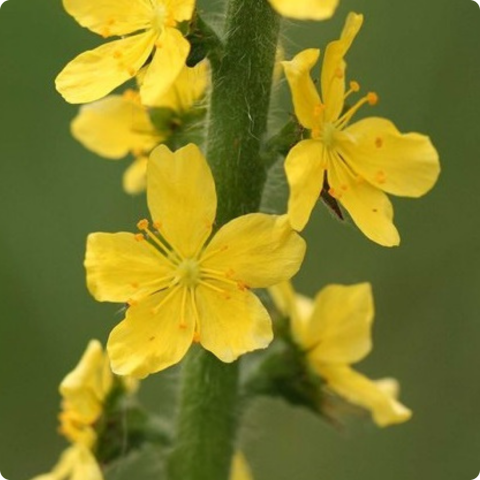Unveiling the Natural Marvel: Agrimony (Agrimonia eupatoria)
A plant that not only captivates with its delicate appearance but also holds a rich tapestry of historical uses and medicinal properties: Agrimony (Agrimonia eupatoria).
A Closer Look at Agrimony
Agrimonia eupatoria, commonly known as agrimony or church steeples, is a perennial herbaceous plant that belongs to the Rosaceae family. This elegant species is native to Europe, Asia, and North Africa, thriving in sunny meadows, woodland edges, and hedgerows. In the Cumbrian countryside, agrimony graces us with its presence, adorning fields and pathways with its slender stems and clusters of vibrant yellow flowers.
Unveiling its Charms
The allure of agrimony lies in its slender, erect stems adorned with pinnate leaves boasting serrated edges, reminiscent of delicate lacework. From late spring to early autumn, these enchanting stems bear clusters of small, five-petaled yellow flowers, attracting bees and butterflies with their nectar-laden blossoms. As the flowers fade, they give way to prickly seed heads, adding an intriguing texture to the plant's aesthetic.
A Rich Tapestry of History and Folklore
Beyond its visual appeal, agrimony holds a captivating history intertwined with folklore and medicinal uses. Throughout the ages, this botanical marvel has been revered for its healing properties, earning it a place in traditional herbal medicine practices. From treating ailments such as diarrhoea and sore throat to soothing skin irritations, agrimony has been a trusted ally in promoting well-being.
In folklore, agrimony has been associated with warding off evil spirits and promoting good fortune. It was believed that carrying agrimony could provide protection from harm and bring luck to those who possessed it. Additionally, agrimony found its way into rituals and ceremonies, where it was used to purify spaces and dispel negative energy.
Harnessing Nature's Bounty
At Cumbria Wildflowers, we recognise the invaluable treasures that nature provides, and agrimony is no exception. While we admire agrimony for its aesthetic beauty, we also honour its role in supporting biodiversity and ecosystem health. As a native species, agrimony contributes to the intricate web of life that sustains our natural landscapes, providing food and habitat for a myriad of insect species.
Cultivating Awareness and Appreciation
As stewards of the land, it is our responsibility to cultivate awareness and appreciation for the natural world around us. Through initiatives such as conservation efforts, educational programs, and sustainable practices, we can ensure that future generations inherit a world where agrimony and its botanical companions continue to thrive.
Embracing Nature's Gifts
In conclusion, agrimony (Agrimonia eupatoria) stands as a testament to nature's boundless beauty and resilience. From its delicate blooms to its storied past, this captivating plant invites us to pause, reflect, and embrace the wonder of the natural world. At Cumbria Wildflowers, we invite you to join us on a journey of discovery as we celebrate the marvels of indigenous flora and the interconnectedness of all living things.
When you subscribe to the blog, we will send you an e-mail when there are new updates on the site so you wouldn't miss them.



Comments